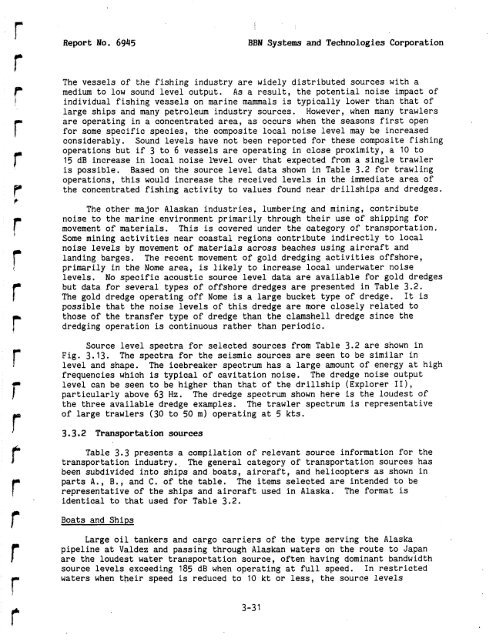Analysis and Ranking of the Acoustic Disturbance Potential of ...
Analysis and Ranking of the Acoustic Disturbance Potential of ...
Analysis and Ranking of the Acoustic Disturbance Potential of ...
You also want an ePaper? Increase the reach of your titles
YUMPU automatically turns print PDFs into web optimized ePapers that Google loves.
Report No. 6945<br />
BBN Systems <strong>and</strong> Technologies Corporation<br />
The vessels <strong>of</strong> <strong>the</strong> fishing industry are widely distributed sources with a<br />
medium to low sound level output. As a result, <strong>the</strong> potential noise impact <strong>of</strong><br />
individual fishing vessels on marine mammals is typically lower than that <strong>of</strong><br />
large ships <strong>and</strong> many petroleum industry sources. However, when many trawlers<br />
are operating in a concentrated area, as occurs when <strong>the</strong> seasons first open<br />
for some specific species, <strong>the</strong> composite local noise level may be increased<br />
considerably. Sound levels have not been reported for <strong>the</strong>se composite fishing<br />
operations but if 3 to 6 vessels are operating in close proximity, a 10 to<br />
15 dB increase in local noise l'evel over that expected from a single trawler<br />
is possible. Based on <strong>the</strong> source level data shown in Table 3.2 for trawling<br />
operations, this would increase <strong>the</strong> received levels in <strong>the</strong> immediate area <strong>of</strong><br />
<strong>the</strong> concentrated fishing activity to values found near drillships <strong>and</strong> dredges.<br />
The o<strong>the</strong>r major Alaskan industries, lumbering <strong>and</strong> mining, contribute<br />
noise to <strong>the</strong> marine environment primarily through <strong>the</strong>ir use <strong>of</strong> shipping for<br />
movement <strong>of</strong> materials. This is covered under <strong>the</strong> category <strong>of</strong> transportation.<br />
Some mining activities near coastal regions contribute indirectly to local<br />
noise levels by movement <strong>of</strong> materials across beaches using aircraft <strong>and</strong><br />
l<strong>and</strong>ing barges. The recent movement <strong>of</strong> gold dredging activities <strong>of</strong>fshore,<br />
primarily in <strong>the</strong> Nome area, is likely to increase local underwater noise<br />
levels. No specific acoustic source level data are available for gold dredges<br />
but data for several types <strong>of</strong> <strong>of</strong>fshore dredges are presented in Table 3.2.<br />
The gold dredge operating <strong>of</strong>f Nome is a large bucket type <strong>of</strong> dredge. It is<br />
possible that <strong>the</strong> noise levels <strong>of</strong> this dredge are more closely related to<br />
those <strong>of</strong> <strong>the</strong> transfer type <strong>of</strong> dredge than <strong>the</strong> clamshell dredge since <strong>the</strong><br />
dredging operation is continuous ra<strong>the</strong>r than periodic.<br />
Source level spectra for selected sources from Table 3.2 are shown in<br />
Fig. 3.13. The spectra for <strong>the</strong> seismic sources are seen to be similar in<br />
level <strong>and</strong> shape. The icebreaker spectrum has a large amount <strong>of</strong> energy at high<br />
frequencies which is typical <strong>of</strong> cavitation noise. The dredge noise output<br />
level can be seen to be higher than that <strong>of</strong> <strong>the</strong> drillship (Explorer II),<br />
particularly above 63 Hz. The dredge spectrum shown here is <strong>the</strong> loudest <strong>of</strong><br />
<strong>the</strong> three available dredge examples. The trawler spectrum is representative<br />
<strong>of</strong> large trawlers (30 to 50 m) operating at 5 kts.<br />
3.3.2 Transportation sources<br />
Table 3.3 presents a compilation <strong>of</strong> relevant source information for <strong>the</strong><br />
transportation industry. The general category <strong>of</strong> transportation sources has<br />
been subdivided into ships <strong>and</strong> boats, aircraft, <strong>and</strong> helicopters as shown in<br />
parts A., B., <strong>and</strong> C. <strong>of</strong> <strong>the</strong> table. The items selected are intended to be<br />
representative <strong>of</strong> <strong>the</strong> ships <strong>and</strong> aircraft used in Alaska. The format is<br />
identical to that used for Table 3.2.<br />
Boats <strong>and</strong> Ships<br />
Large oil tankers <strong>and</strong> cargo carriers <strong>of</strong> <strong>the</strong> type serving <strong>the</strong> Alaska<br />
pipeline at Valdez <strong>and</strong> passing through Alaskan waters on <strong>the</strong> route to Japan<br />
are <strong>the</strong> loudest water transportation source, <strong>of</strong>ten having dominant b<strong>and</strong>width<br />
source levels exceeding 185 dB when operating at full speed. In restricted<br />
waters when <strong>the</strong>ir speed is reduced to 10 kt or less, <strong>the</strong> source levels
















